 |
 |
|
 |
 |
West-Germany: ZEISS IKON AG: 1953-1972:
A flagship going down
The West-German branch of the Zeiss Ikon brand, built up in Stuttgart after the war as the "main office", had problems realizing what was going on in the new camera world as not only the East-Germans, but Italians, Swiss, Hungarian, British and even
French cameras were ahead of them in the field of eye level slrs. Their answer initiated a wave of not so good looking, heavy cameras with a central shutter in the lens. Most West-German brands followed this trend, Wirgin Edixa being the only one to chose
another path. So, if they could not make the best cameras, their policy to get big marked shares in Europe was to hunt down the East-Germans by law suits that forced them to change camera name from Contax to Pentacon, and lens name from Carl Zeiss, Jena, to
CZJ or just Jena, or Pentacon, among other names. All kinds of obstacles were set up to keep the East-Germans out of western markets, and with full support of the real commanding officer, the US administration. To discredit the East-Germans further, even the
M42 mount, born with the Contax S and the Praktica, was named Pentax mount in the west, as Pentax had adopted the mount and spread it among other brands.
For a relatively short time, this policy was rewarded with high sales for West-German brands in the
west. Zeiss Ikon AG had released the Contaflex in 1953, and it was a leader in the west for some years, until sales dropped and production was stopped in 1968. ZI AG had for long been lacking the technology of the Japanese, and even lost against the remaining
East-Germans, i.e. Praktica. Presented in 1958, with start of production in '59 and generally available from 1960, Zeiss Ikon AG came up with a camera that was meant to knock out the competition among the pros. Their new star was the Contarex. But it
was ugly, heavy and very expensive, and still had no IRM. Quality was good, a variety of high class lenses were offered with it, as ZI finally understood the shortcomings of the leaf shutter. But the Contarex was no big success, and was only produced until
1966. Most West-German brands went out of business during the 60s, and Zeiss Ikon was losing too. What had been earned through many years in leading position, got wings to fly on as developing and production costs by far surpassed sales income.
In 1965 Zeiss Ikon AG merged with, or finally took over Voigtländer, after some 10 years as minority stock holder. Voigtländer was just developing a couple of interesting models at the same time. Bessaflex was a more modern camera than Contaflex,
and could have been the camera that ZI needed. But the plans were put aside.
Instead, another Voigtländer construction was released, the Icarex in 1966. That was going to be the preferred ZI camera until all camera production was ended in 1972.
But the name was not dead: Zeiss went into a co-operation with Yashica of Japan, and in 1975 the Contax RTS was born! This camera, and the later Kyocera/Contaxes, are described or listed in this chapter as well as under Yashica. Still, the
end of Carl Zeiss Stuttgart is defined to be 1972.
 Contaflex was introduced in 1953, and was the first PP SLR from West Germany. But this western branch of Zeiss Ikon Conteflex was the first PP SLR from West-Germany and the first with Leaf Shutter, a shutter build into the lens. The camera came in many versions in the years to come. Here is one from the first edition., with a fixed 45 mm lens. Size: 127x90x51mm. Weight: 684 g. Sn. N 38855.
Contaflex was introduced in 1953, and was the first PP SLR from West Germany. But this western branch of Zeiss Ikon Conteflex was the first PP SLR from West-Germany and the first with Leaf Shutter, a shutter build into the lens. The camera came in many versions in the years to come. Here is one from the first edition., with a fixed 45 mm lens. Size: 127x90x51mm. Weight: 684 g. Sn. N 38855.
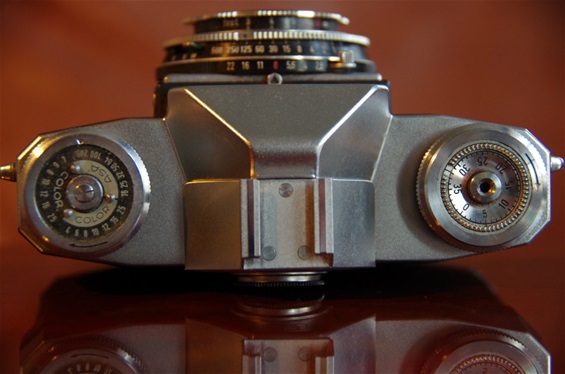 Simple layout: Winder with counter and shutter release button to the right. Rewind knob with DIN scale to the left. Aperture, shutter speed and focus ring on the lens. The flashshoe on the prism house was extra.
Simple layout: Winder with counter and shutter release button to the right. Rewind knob with DIN scale to the left. Aperture, shutter speed and focus ring on the lens. The flashshoe on the prism house was extra.
 Carl Zeiss fixed Tessar Synchro-Compur 45/2.8. Sn. 1692569.
Carl Zeiss fixed Tessar Synchro-Compur 45/2.8. Sn. 1692569.
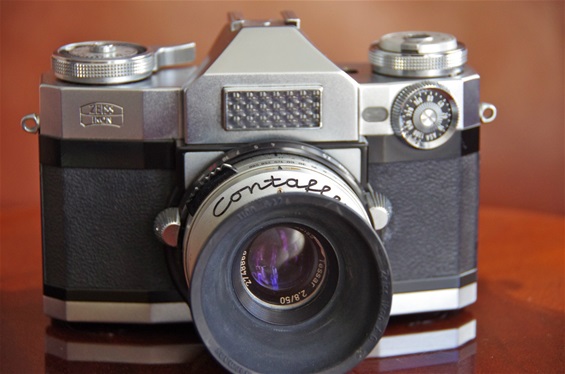 A later Contaflex of 1959, now with interchangeable lenses, winder arm and selenium metering. Sn. Y 88621.
A later Contaflex of 1959, now with interchangeable lenses, winder arm and selenium metering. Sn. Y 88621.
 Winder arm to the right. A dial at the upper left front to adjust setting according to metering.
Winder arm to the right. A dial at the upper left front to adjust setting according to metering.
1960: Contarex:
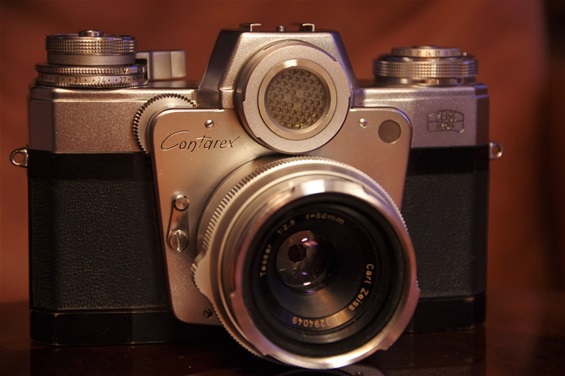 Zeiss ikon Contarex of 1960. Called Bulls Eye due to the selenium light meter mounted in front of the prism. A dominating eye. The camera was HEAVY, as it consisted of very many parts and had high build quality.
Weight: 1065 grams. Size: 154x105x64 mm. Sn. T 90367.
Zeiss ikon Contarex of 1960. Called Bulls Eye due to the selenium light meter mounted in front of the prism. A dominating eye. The camera was HEAVY, as it consisted of very many parts and had high build quality.
Weight: 1065 grams. Size: 154x105x64 mm. Sn. T 90367.
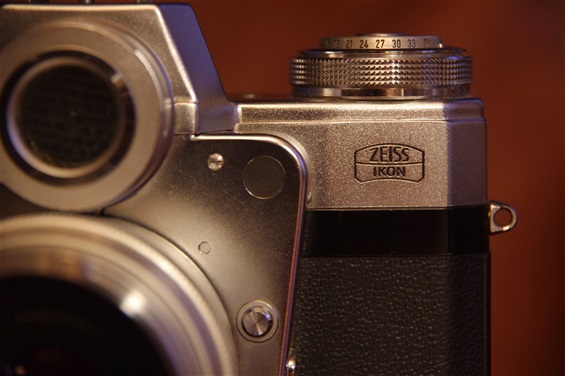 Zeiss Ikon family..
Zeiss Ikon family..
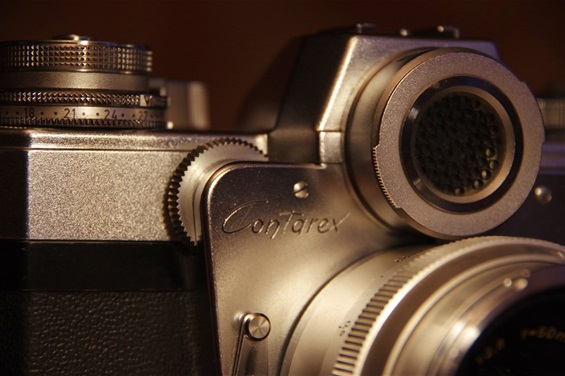 Contarex with the bulls eye. Aperture settings was operated from the vertical dial behind the Contarex logo. ASA settings by the lowest dial under the winder.
Contarex with the bulls eye. Aperture settings was operated from the vertical dial behind the Contarex logo. ASA settings by the lowest dial under the winder.
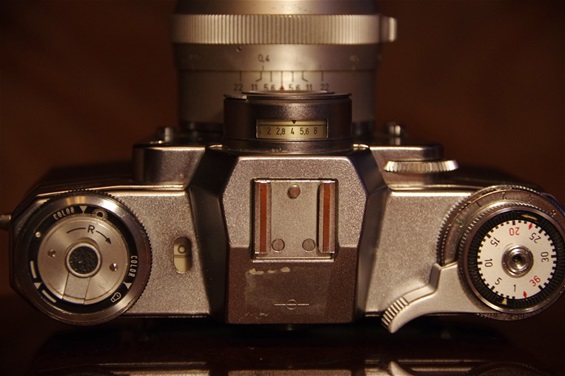 Foldable crank rewinder to the left. Flash shoe on the prism house.
Foldable crank rewinder to the left. Flash shoe on the prism house.
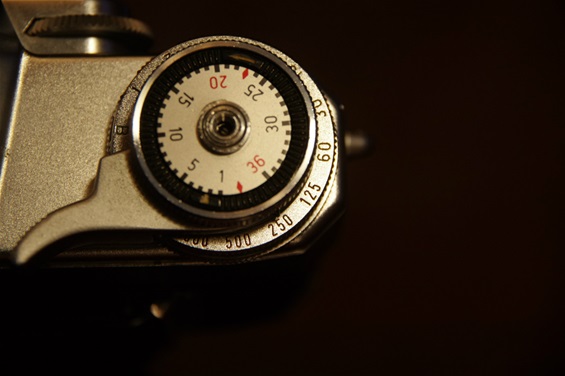 Here it starts to get crowded: winder, frame counter, ASA/DIN dial, shutter speed dial and shutter release button, all placed around the same axis on the right hand side.
Here it starts to get crowded: winder, frame counter, ASA/DIN dial, shutter speed dial and shutter release button, all placed around the same axis on the right hand side.
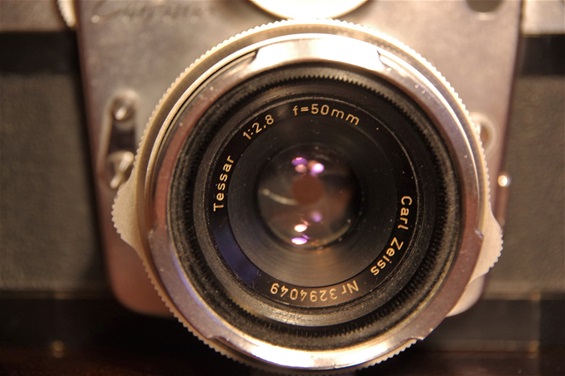 A very smooth focusing ring on this Carl Zeiss Tessar 50/2,8.
Sn. 3294049.
A very smooth focusing ring on this Carl Zeiss Tessar 50/2,8.
Sn. 3294049.
1966: Icarex 35:
Although developed by Voigtländer, the introduction of the Icarex 35 had to wait until after the merger with Zeiss Ikon in 1965. The Icarex was the third in the row of PP SLRs form Zeiss Ikon AG, and introducing the third mount. This, of course
limited the variety of lenses. So, in 1970, ZI introduced an Icarex with M42 mount, but it did not help. Production of the Icarex was terminated in 1971.
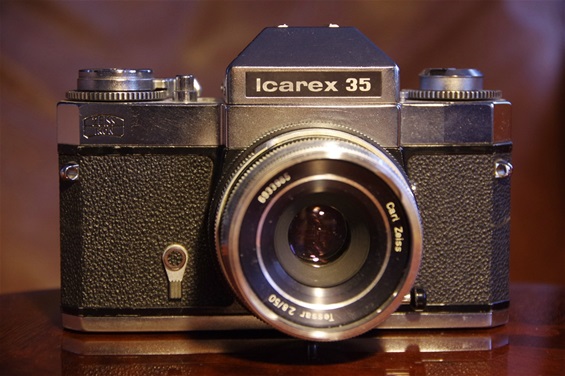 The Icarex 35 of '66 had an interchangeable viewfinder with three versions: ordinary penta prism as seen here, traditional waist level prism and the metering CS prism. Weight: 743 grams. Size: 146x96x53 mm. Sn. P 27311.
The Icarex 35 of '66 had an interchangeable viewfinder with three versions: ordinary penta prism as seen here, traditional waist level prism and the metering CS prism. Weight: 743 grams. Size: 146x96x53 mm. Sn. P 27311.
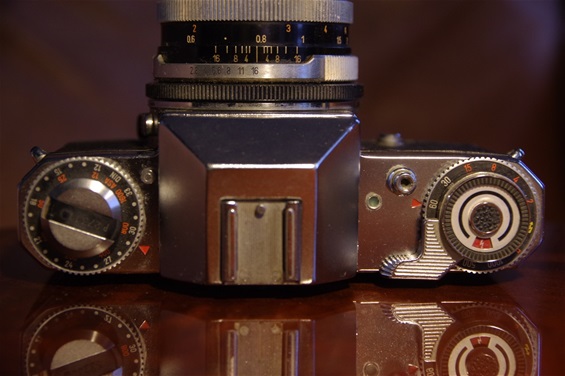 ASA/DIN settings to the left, around rewinder. Shutter time setting around winder to the right. Winder has a very long stroke.
ASA/DIN settings to the left, around rewinder. Shutter time setting around winder to the right. Winder has a very long stroke.
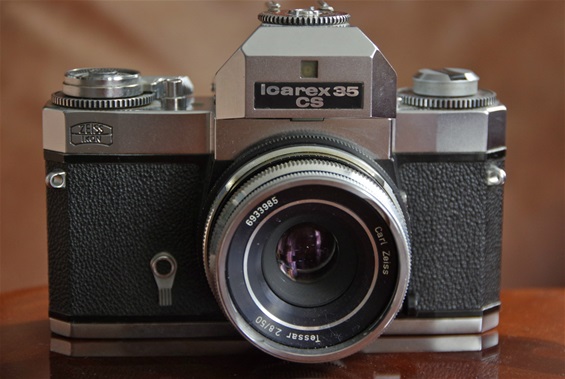 The CS version: Weight: 791 grams. Size: 146x102x63mm. (House with CS prism.) Sn. N 7582.
The CS version: Weight: 791 grams. Size: 146x102x63mm. (House with CS prism.) Sn. N 7582.
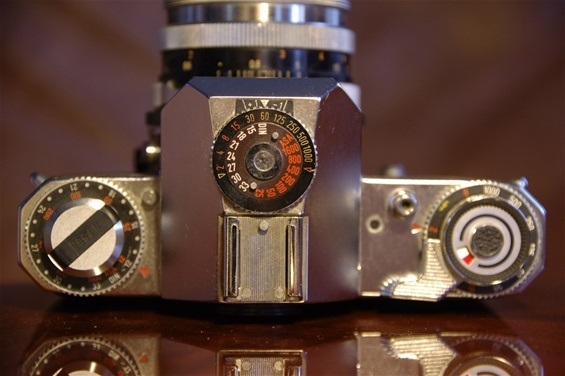 The CS meter was operated as follows: set the ASA/DIN value. (Inner dial on top of the prism.) Set the shutter speed on shutter speed dial and on CS meter dial. The aperture values are seen in the viewer above the subject. Turn the aperture ring on the lens until an arrow hits a circle in the viewer.
The advantage over the Bessamatic from '59 was that one could see the values in the viewer. But compared to the two years older Pentax Spotmatic, this Icarex was already far behind.
The CS meter was operated as follows: set the ASA/DIN value. (Inner dial on top of the prism.) Set the shutter speed on shutter speed dial and on CS meter dial. The aperture values are seen in the viewer above the subject. Turn the aperture ring on the lens until an arrow hits a circle in the viewer.
The advantage over the Bessamatic from '59 was that one could see the values in the viewer. But compared to the two years older Pentax Spotmatic, this Icarex was already far behind.
Zeiss Ikon and Voigtländer marked at the back..
but only Zeiss Ikon at the front.
1975: Contax RTS:
Knocked out by the Japanese smaller, lighter, technically more advanced and less expensive cameras, Zeiss Ikon AG in West-Germany finally had to admit that the hegemony, and the game, was over. Even the East-Germans had far bigger success with their
Prakticas than the somewhat arrogant big brothers in the west. The people at VEB Pentacon in Dresden must have had a laugh as the company that forced them to change names after winning the cases in western courts now had to give up production, while Prakticas
were sold in millions. But Zeiss Ikon didn't quite give up. They admitted that if you cannot beat them, join them.
So, Zeiss went eastwards, all the way to Japan to cooperate. They chose Yashica as partner. From 1975, a new Contax
was born, the RTS produced by Yashica. Lenses wore the name of Zeiss, Yashinon or Yashica, depending on the price tag. From 1982, the slighly developed RTS II was released. In 1983, Yashica was taken over by Kyocera, Kyoto Ceramic Company Ltd.
That was just before autofocus SLRs entered the scene, and Contax/Yashica did not manage to stand out among the few SLR camera producers still alive. But good quality cameras were still produced, including RTS II and III (1990), different versions of 137,
139, 159 and 167-models. Then ST (1992), S2 (1992-2000), S2b (1994-2000), RX (1994) with focus assistance, AX (1996, AF, but not successful), Aria (1998-2004) and lastly the RX II in 2002. Contax never made it into the digital era, and Kyocera stopped camera
production in 2005. The Kyocera company is still operating in different sectors, with more than 70 000 employees worldwide.
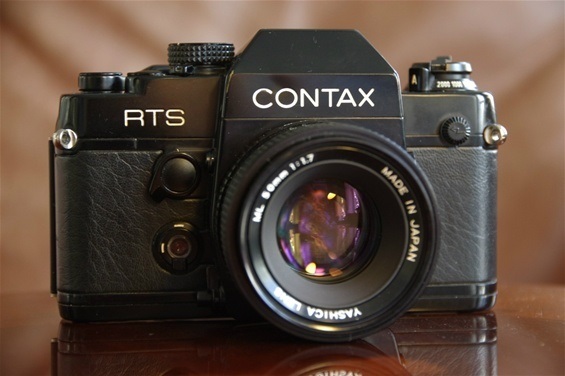 The Contax RTS was a quality product. The first RTS came in 1975, the RTS II Quartz in 1982, and the final one, the RTS III in 1990. Here is an RTS II Quartz.
The Contax RTS was a quality product. The first RTS came in 1975, the RTS II Quartz in 1982, and the final one, the RTS III in 1990. Here is an RTS II Quartz.
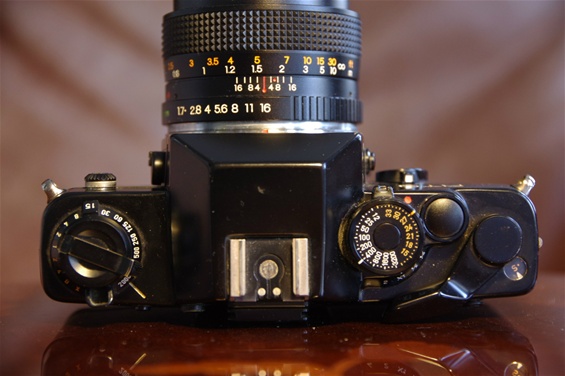 Allthough built in 1982, the design of handles was more or less the well known Pentax design from 1957, although the shutter time and ASA/DIN values had switched places.
Allthough built in 1982, the design of handles was more or less the well known Pentax design from 1957, although the shutter time and ASA/DIN values had switched places.
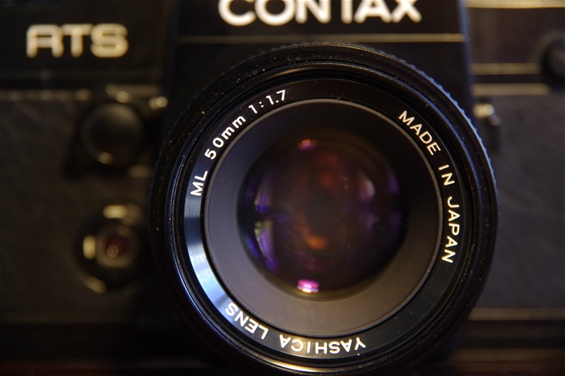 A Yashica branded lens on this one, which reduced the kit price substantially compared to the Carl Zeiss branded ones.
A Yashica branded lens on this one, which reduced the kit price substantially compared to the Carl Zeiss branded ones.
|
|
 |
|
|
|